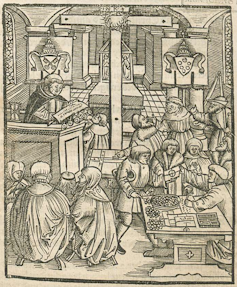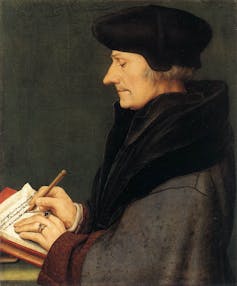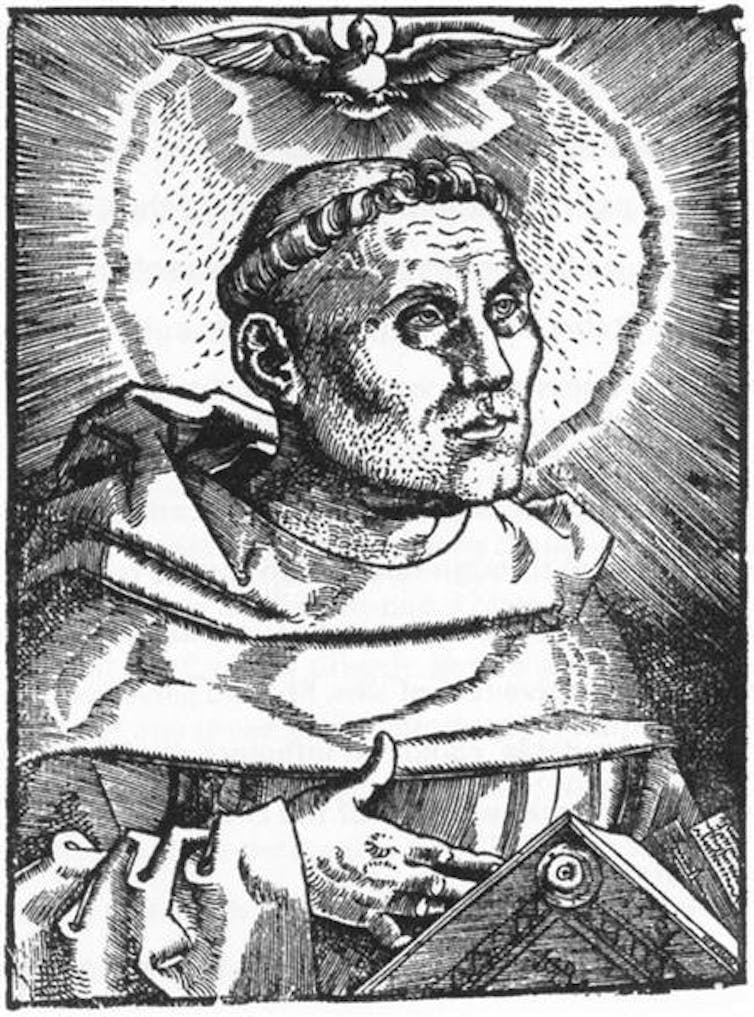Revisiting the Reformation: how passions sparked a religious revolution 500 years ago
- Written by Susan Broomhall, Director, Centre for Medieval and Early Modern Studies, University of Western Australia
October 31 2017 marks 500 years to the day when Martin Luther famously sent his Ninety-Five Theses to Cardinal Albrecht of Brandenburg, the Archbishop of Mainz, criticising what he saw as corruption in the Roman Catholic Church. This moment is usually seen as the beginning of the Reformation, and the birth of Protestant Christianity, whose denominations together claim close to a billion members today.
But simplifying the story of the Reformation to this one act obscures the many individuals and factors that were essential to this movement becoming a spiritual revolution.
As with all movements, the Reformation was generated and sustained by strong passions about powerful ideas and emotional attachment to figureheads. Scholars are increasingly recognising their significance.
For Luther was not the first or the only person of his age to hold views critical of the contemporary church but, in 1517, these ideas were projected through a sophisticated media package of emotional rhetoric and images that intensified their potency.
Contemporary fears about sin and anxieties about greed were at the heart of the concerns that Luther voiced. In 1515, the Pope, Leo X, had sought funding to complete the re-building of St Peter’s Basilica in Rome through an indulgence campaign. Indulgences were certificates that Christians could purchase in order to reduce the time they would have to spend in penance for their sins. Over time, the institution of indulgences had become hugely popular and profitable, and was increasingly criticised for its abuses.
 Indulgence selling in a church, Augsburg, 1521.
Jfhutson/Jeanjung212, Wikipedia
Indulgence selling in a church, Augsburg, 1521.
Jfhutson/Jeanjung212, Wikipedia
For example, in 1517 in Mainz, a German city then part of the Holy Roman Empire, half of the funds raised from the indulgences were instead diverted to the Cardinal. On October 31, Luther – a monk and lecturer in theology at the University of Wittenberg – wrote to the Cardinal to complain.
He included a Latin essay, with 95 different points, questioning the practice of indulgences. This work hit a nerve not just with the Cardinal; a significant number of people wanted to read Luther’s concerns. Within weeks, the Ninety-Five Theses were widely published in Germany, in Latin and then German, and were soon available all across Europe.
Voicing anger and passion
Luther was emboldened and his criticisms grew stronger. In the provocatively entitled treatise The Babylonian Captivity of the Church of 1521, his previously nuanced critique of indulgences was reduced to one proposition: they were “a swindler’s trick”, and many other church teachings and practices had become “wicked and despotic”.
Luther’s increasingly vocal denouncements of church institutions drew strong emotional reactions, even among those who supported reforming the church. The scholar Erasmus of Rotterdam was one of them.
 Hans Holbein, portrait of Erasmus.
Wikimedia
Hans Holbein, portrait of Erasmus.
Wikimedia
Erasmus, who was accused of “laying the egg that Luther hatched” for bringing humanistic studies to bear on the Bible, described the dissent that Luther was fomenting as a tragedy, fearing “the evils surrounding that wretched Luther” would lead to increased attacks on the humanities by monks and conservative theologians. These fears were exacerbated by what Erasmus perceived as overly passionate language of Luther’s followers, the Lutherans.
Even those who ultimately would come to support these ideas disliked Luther’s approach to stirring up support for the movement. Wolfgang Capito, a future Protestant, wrote to Erasmus in 1521:
The Lutherans are crazier, excessive, and more arrogant than ever; they fix their teeth on anybody, and reproach everyone to their face with shameless barbarity.
In 1534, Erasmus found himself under attack from Luther as “the devil incarnate”. Erasmus responded that Luther was “harsh, violent, and Procrustean, always spewing tragedy”.
Erasmus proposed that Luther should instead:
teach through arguments, then, if the situation demands, agitate the emotions; but one should not casually stir up the more violent feelings known as passions. Truly to never stop being vehement, to never stop crying out vehemently with tragic words, is madness rather than eloquence.
However, the Dutch humanist’s calls for moderation would fall on deaf ears, and the movement surrounding Luther grew stronger, dividing European Christianity forever.
The emotional power of images
The movement’s power did not just stem from passionate words though. The painter and printmaker Lucas Cranach the Elder played a crucial role in creating Luther’s public image ahead of the Diet of Worms, a political assembly, where, in April 1521, Luther was expected - but eventually refused - to retract his criticisms.
Cranach employed two visual strategies to justify Luther’s positions. In one engraving, he portrayed the reformer as a scholar whose critical views on the church’s practice were valid because he had closely scrutinised the word of God. In a second print, Cranach showed Luther as an ascetic monk in devout communion with his faith, standing in a niche similar to those in which sculptures of saints were commonly displayed in Catholic churches.
While Cranach had only subtly hinted at Luther’s saint-like status, other artists soon underlined this association by depicting Luther surrounded by a halo or inspired by the spirit of the Holy Dove.
 Hans Baldung, Portrait of Martin Luther, 1521.
Wikiart
Hans Baldung, Portrait of Martin Luther, 1521.
Wikiart
The emotional power of such prints stemmed partly from the fact that soon after the Diet, Luther had disappeared from public view. Having been excommunicated and declared an outlaw by the Pope and the Emperor, he remained hidden in great secrecy at Wartburg castle until the spring of 1522. Luther’s disappearance, and presumed death as a martyr to his faith, only helped to enhance his popularity, and that of his printed image.
For Catholic viewers, Luther prints caused great concerns. Cardinal Girolamo Aleandro was horrified not only about the inappropriate depictions of a convicted heretic as a saint, but also about the reverence paid to such images by the masses:
There are recent pictures of Luther with the symbol of the Holy Ghost above his head, or with the cross. And there is another print in which he is shown in glory. And people buy these things and they kiss them!
These portraits were thus not only successful at creating a visual defence of Luther’s positions, but their reception highlights the emotional engagement of the masses with this public persona.
Movements often create origin stories and figureheads, but the success of the Reformation was forged not by any one man, but by emotions that the many who aided the spread of these ideas, engaged and galvanised in word, in print, and in image.
Authors: Susan Broomhall, Director, Centre for Medieval and Early Modern Studies, University of Western Australia





